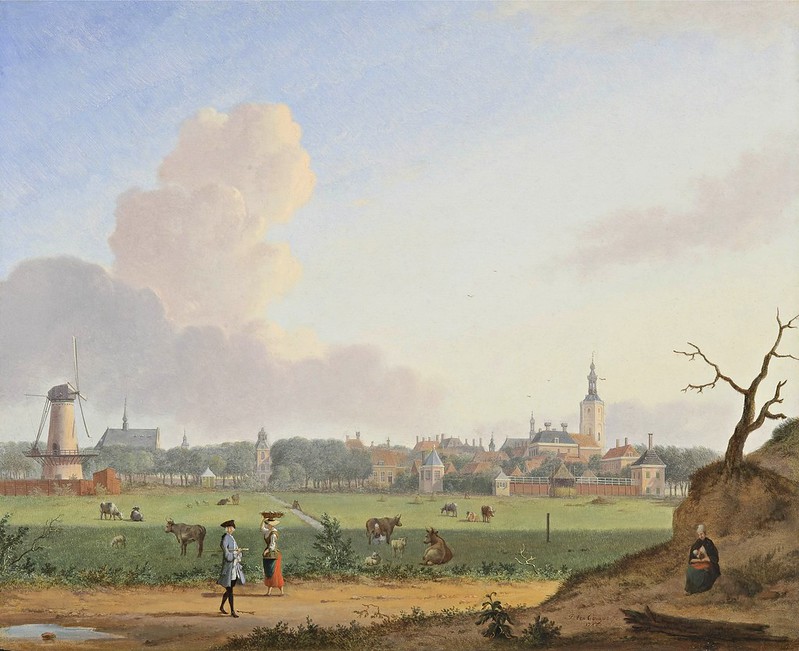Obra de Jan ten Compe (1713-1761), pintor holandès (1)
- Recordatori de Johan Daniel Berlin -
En el dia de la celebració del seu 302è aniversari de naixement
Parlem de Pintura...
Jan ten Compe (Amsterdam, 14 de febrer de 1713 - Amsterdam, 11 de novembre de 1761) va ser un pintor holandès, especialitzat en paisatges i vistes urbanes. Segons Jan van Gool, el seu biògraf, va ser seguidor de Jan van der Heyden i Gerrit Berckheyde. Alumne de Dirck Dalens III, la seva obra va ser habitualment sota demanda de patrons i aristòcrates com l'alcalde Rendorp d'Amsterdam i Mr. De Groot de la Haia. Ten Compe es va centrar en temàtica paisatgística rebent gran acceptació al seu temps. Va treballar també com a professor amb alumnes, entre altres, com Geerit Toorenburgh. Va morir a Àmsterdam el novembre de 1761.
Font: En català: No disponible - En castellano: No disponible - In english: Jan ten Compe (1713-1761) - Altres: Jan ten Compe (1713-1761)
Parlem de Música...
Johan Daniel Berlin (Memel, 12 de maig de 1714 - Trondheim, 4 de novembre de 1787) va ser un organista i compositor alemany. Va estudiar orgue amb el seu pare Heinrich Berlin abans de viatjar el 1730 a Copenhagen on es va convertir en alumne d'Andreas Berg, el músic més famós de la capital danesa. El 1737 Berlin va rebre el nomenament de músic de la ciutat de Trondheim, un càrrec que va mantenir fins el 1767. A partir del 1740, va assolir el càrrec d'organista de la Catedral de Trondheim convertint-se en un dels músics més importants del segle XVIII a Noruega. Les seves labors van ser molt diverses; des de publicacions musicals teòriques, llibres d'astronomia, meteorologia i altres, passant per la construcció d'instruments o com a inspector de les obres hidràuliques de la ciutat i fins i tot va ser cartògraf i arquitecte. Va ser també un insaciable col·leccionista de música i literatura del país nòrdic. Va ser molt conegut per la seva publicació Musikalske elementer (Trondheim, 1744), una eina de treball que va ajudar en el desenvolupament de la música a Noruega. Va ser també un dels membres fundacionals de l'Associació Científica Noruega (1760). Va ser l'inventor, entre altres, d'un peculiar instrument per nom 'cembalo da gamba verticale'. El gener de 1787 va ser triat membre de la junta directiva de la Societat de Música de Trondheim. Com a compositor va escriure una trentena d'obres, principalment concerts i 3 simfonies. Va morir a Trondheim el novembre de 1787.
OBRA:
all MSS are in N-T
Edition: John Daniel Berlin: The Collected Works, ed. B. Korsten (Bergen, 1977)
Vocal religiosa:
2 cants, lost
Instrumental:
Orch:
3 syms.;
6 hpd concs., lost;
Vn Conc.;
Conc., cembalo da gamba verticale, lost;
Conc., b viol, lost
Other works:
6 Dants-Menuetter, vn, bc (Copenhagen, 1766);
Sonatina, hpd (Augsburg, 1751), ed. in Norsk musikksamling, i (Oslo, 1953);
8 minuets, hpd;
5 sonatas, 2 b viol, lost;
Literatura:
Musikalske elementer (Trondheim, 1744), ed. B. Korsten (Bergen, 1977)
Anleitung zur Tonometrie, oder Wie man durch Hülfe der logarithmischen Rechnung nach der geometrischen Progressionsrechnung die so gennante gleichschwebende musikalische Temperatur leicht und bald ausrechnen kann (Copenhagen and Leipzig, 1767); ed. B. Korsten (Bergen, 1976)
OBRA:
all MSS are in N-T
Edition: John Daniel Berlin: The Collected Works, ed. B. Korsten (Bergen, 1977)
Vocal religiosa:
2 cants, lost
Instrumental:
Orch:
3 syms.;
6 hpd concs., lost;
Vn Conc.;
Conc., cembalo da gamba verticale, lost;
Conc., b viol, lost
Other works:
6 Dants-Menuetter, vn, bc (Copenhagen, 1766);
Sonatina, hpd (Augsburg, 1751), ed. in Norsk musikksamling, i (Oslo, 1953);
8 minuets, hpd;
5 sonatas, 2 b viol, lost;
Literatura:
Musikalske elementer (Trondheim, 1744), ed. B. Korsten (Bergen, 1977)
Anleitung zur Tonometrie, oder Wie man durch Hülfe der logarithmischen Rechnung nach der geometrischen Progressionsrechnung die so gennante gleichschwebende musikalische Temperatur leicht und bald ausrechnen kann (Copenhagen and Leipzig, 1767); ed. B. Korsten (Bergen, 1976)
Parlem en veu pròpia o en veu d'altri...
Booklet notes
Gaudiu i compartiu!
Informació addicional...
RECICLASSICAT: BERLIN, Johan Daniel (1714-1787)
AMAZON: BERLIN, J.D. - Concertos, Sinfonias et al
CPDL: No disponible
SPOTIFY: BERLIN, J.D. - Concertos, Sinfonias et al

Tant si us ha agradat, com si no, opineu, és lliure i fàcil!

Tant si us ha agradat, com si no, opineu, és lliure i fàcil!

Un administrador del blog ha eliminat aquest comentari.
ResponEliminaUna buena aportación tanto por lo extraño como por la calidad musical e interpretativa.
ResponEliminaMuchas gracias¡
Josep.